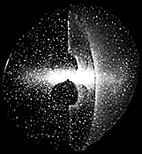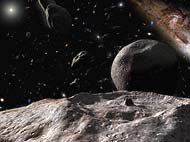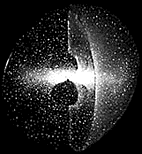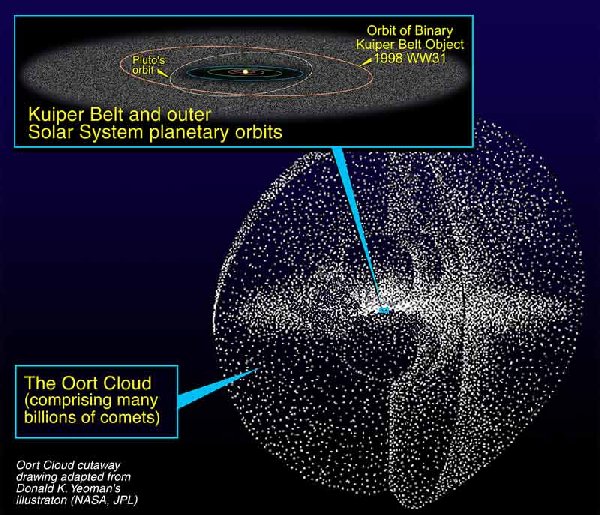

Many people believe that the boundary to our Solar System is just less than six thousand million miles (9.6 thousand million kilometres) from the Sun at Pluto's orbit. However the Kuiper Belt, which contains thousands of planetoids and icy bodies, lies beyond Pluto's orbit and is part of our Solar System. The Kuiper Belt is thought to be the source of many short period comets and many of the moons of Uranus and Neptune are believed to be captured Kuiper Belt objects. Quaoar was discovered and is a large Kuiper Belt object further out than Pluto. Pluto and its moon Charon are the largest examples of Kuiper Belt objects, however Pluto, for historic reasons, will retain its designation as a planet.
There are believed to be 35,000 Kuiper Belt objects larger than 63 miles (100 kilometres) and this makes it several hundred times the number and mass of similar sized objects in the asteroid belt.
Kuiper Belt objects that orbit between Neptune and Jupiter (nine of which are known) are called Centaurs. One if these "refugees" is 106 miles (170 kilometres) in diameter making it 20 times larger than Halley's Comet and will be spectacular if it ever acquires at tail by passing close enough to the Sun.
However even after the Kuiper Belt the Solar System doesn't end. The boundary of our Solar System is in fact so far away that it is half way to the nearest star!

Orbiting the Solar System with the inner edge at a distance or 5,000 astronomical units and stretching to a distance of 100,000 astronomical units is an enormous cloud called the Oort Cloud. An Astronomical Unit is the average distance between the Sun and Earth. Its value is 93 million miles (150 million kilometers).
The Oort Cloud is named after Jan Oort who first suggested it existed. The Oort Cloud consists of comets and icy objects and contains somewhere in the region of six million, million comets. Many of the long period comets of the Solar System come from here.

It is believed that the Oort Cloud bodies, formed closer to the Sun than the Kuiper Belt, where ejected, from the Solar System, from their original places between the giant planets. Those that didn't escape formed the Oort Cloud. Objects that formed further out became part of the Kuiper Belt.
When a planetary nebula, another star or another star's Oort Cloud pass to close to ours the gravity can send a comet either out into interstellar space or to begin its 20 million year journey into the inner Solar System where the planets live. Forces from the Milky Way's gravitational disk can also affect the comets as can a pull towards the galactic centre. The comets can be violently redistributed when a giant molecular cloud passes by. They are the birthplaces of stars and solar systems and are infrequently encountered. Only once every 300-500 million years. Comets beyond 200,000 astronomical units are easily lost into interstellar space.
The comets in the Oort Cloud are usually tens of millions of miles apart and most of the comets are found in the dense core. The outer boundaries only contain about one sixth of the comets. The core continually replenishes the outer boundaries and that creates a steady state. The Oort Cloud is estimated to have a mass of about 40 times that of the Earth.

In about 820,000 years an as yet unnamed star will pass directly through the Oort Cloud and will pass within only 1/5 of a light year from the Sun (about 625 thousand million miles or 1 million, million kilometres). This will create the most amazing comet shower with about 10,000 comets in the sky in one night! We know that 65 million years ago, a comet or asteroid struck the Earth and wiped out the dinosaurs so although this shower is a long way off, who knows what could happen to the Earth if one such comet passed to close?
Return to Mars and outer planets trading post.
Go to top.